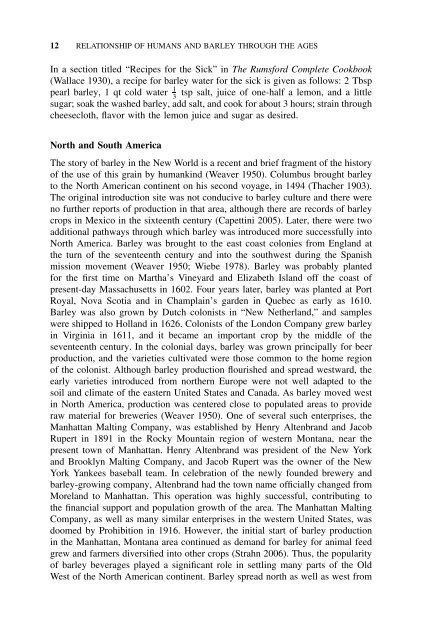Barley for Food and Health: Science, Technology, and Products
Barley for Food and Health: Science, Technology, and Products
Barley for Food and Health: Science, Technology, and Products
Create successful ePaper yourself
Turn your PDF publications into a flip-book with our unique Google optimized e-Paper software.
12 RELATIONSHIP OF HUMANS AND BARLEY THROUGH THE AGES<br />
In a section titled “Recipes <strong>for</strong> the Sick” in The Rums<strong>for</strong>d Complete Cookbook<br />
(Wallace 1930), a recipe <strong>for</strong> barley water <strong>for</strong> the sick is given as follows: 2 Tbsp<br />
pearl barley, 1 qt cold water 1 3<br />
tsp salt, juice of one-half a lemon, <strong>and</strong> a little<br />
sugar; soak the washed barley, add salt, <strong>and</strong> cook <strong>for</strong> about 3 hours; strain through<br />
cheesecloth, flavor with the lemon juice <strong>and</strong> sugar as desired.<br />
North <strong>and</strong> South America<br />
The story of barley in the New World is a recent <strong>and</strong> brief fragment of the history<br />
of the use of this grain by humankind (Weaver 1950). Columbus brought barley<br />
to the North American continent on his second voyage, in 1494 (Thacher 1903).<br />
The original introduction site was not conducive to barley culture <strong>and</strong> there were<br />
no further reports of production in that area, although there are records of barley<br />
crops in Mexico in the sixteenth century (Capettini 2005). Later, there were two<br />
additional pathways through which barley was introduced more successfully into<br />
North America. <strong>Barley</strong> was brought to the east coast colonies from Engl<strong>and</strong> at<br />
the turn of the seventeenth century <strong>and</strong> into the southwest during the Spanish<br />
mission movement (Weaver 1950; Wiebe 1978). <strong>Barley</strong> was probably planted<br />
<strong>for</strong> the first time on Martha’s Vineyard <strong>and</strong> Elizabeth Isl<strong>and</strong> off the coast of<br />
present-day Massachusetts in 1602. Four years later, barley was planted at Port<br />
Royal, Nova Scotia <strong>and</strong> in Champlain’s garden in Quebec as early as 1610.<br />
<strong>Barley</strong> was also grown by Dutch colonists in “New Netherl<strong>and</strong>,” <strong>and</strong> samples<br />
were shipped to Holl<strong>and</strong> in 1626. Colonists of the London Company grew barley<br />
in Virginia in 1611, <strong>and</strong> it became an important crop by the middle of the<br />
seventeenth century. In the colonial days, barley was grown principally <strong>for</strong> beer<br />
production, <strong>and</strong> the varieties cultivated were those common to the home region<br />
of the colonist. Although barley production flourished <strong>and</strong> spread westward, the<br />
early varieties introduced from northern Europe were not well adapted to the<br />
soil <strong>and</strong> climate of the eastern United States <strong>and</strong> Canada. As barley moved west<br />
in North America, production was centered close to populated areas to provide<br />
raw material <strong>for</strong> breweries (Weaver 1950). One of several such enterprises, the<br />
Manhattan Malting Company, was established by Henry Altenbr<strong>and</strong> <strong>and</strong> Jacob<br />
Rupert in 1891 in the Rocky Mountain region of western Montana, near the<br />
present town of Manhattan. Henry Altenbr<strong>and</strong> was president of the New York<br />
<strong>and</strong> Brooklyn Malting Company, <strong>and</strong> Jacob Rupert was the owner of the New<br />
York Yankees baseball team. In celebration of the newly founded brewery <strong>and</strong><br />
barley-growing company, Altenbr<strong>and</strong> had the town name officially changed from<br />
Morel<strong>and</strong> to Manhattan. This operation was highly successful, contributing to<br />
the financial support <strong>and</strong> population growth of the area. The Manhattan Malting<br />
Company, as well as many similar enterprises in the western United States, was<br />
doomed by Prohibition in 1916. However, the initial start of barley production<br />
in the Manhattan, Montana area continued as dem<strong>and</strong> <strong>for</strong> barley <strong>for</strong> animal feed<br />
grew <strong>and</strong> farmers diversified into other crops (Strahn 2006). Thus, the popularity<br />
of barley beverages played a significant role in settling many parts of the Old<br />
West of the North American continent. <strong>Barley</strong> spread north as well as west from

















